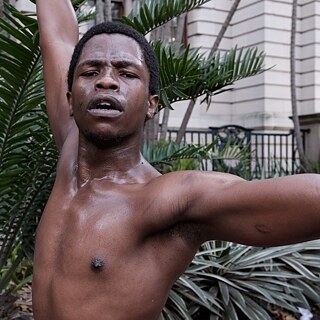Durban is often treated as the distant relation of South Africa’s two other major cities, Johannesburg and Cape Town. This notwithstanding KwaZulu-Natal’s mythical status as the place of the ‘People of the Heavens’ (the Zulu nation), and the city’s renown for having the largest population of Indians outside India. But Durban refuses to surrender its uniqueness: it prides itself on being a place that incubates some of the country’s greatest hearts and minds.
The Durban Art Gallery was the chosen location for the start of the Power Talks Durban. The gallery has a long history of igniting young artists' careers, and this day was no different, as the acclaimed artist Mary Sibande was, at the very same time, conducting a walkabout through a body of her work entitled ‘Let Me Tell You About Red’.Mary has an innocent quietness; her quivering voice and sweaty palms likely went unnoticed by many onlookers. Her speech, which was punctuated by soft gasps for breath, came to an abrupt halt when a piercing sound blasted through the main auditorium. Mary nervously skittered across the room, landing up beside me. She was visibly shaken, but also relieved, as she confided to me in a whisper, to no longer have all eyes on her.
What followed the piercing sound was a performance by a feminine figure in cherry-red stilettos, whose posture on arrival was quite regal, but which progressively deteriorated, becoming more and more broken and slumped, ending up in the most vulnerable state. This performance evoked a defeated mood, which so contrasted with the dominating scale of female heroism displayed in Mary’s artwork that I was left feeling quite confused. As I tried to moderate myself and depart from the sense of melancholy, choral voices suddenly came from the passage and erupted into the auditorium. The voices belonged to performers from the KwaMashu Community Advancement Projects (KCAP), and the journey that followed included a recollection and retelling of the story of colonialism.
After descending the gallery stairs, guided by the KCAP performers channelling the ‘People of the Heavens’, we all spilled out onto Smith Street. Seeing the performers stomp with their bare feet on the hard, urban fabric, before entering a church with brutalist architecture; and then to be greeted, at the end of our journey, by Indian cuisine (which summoned the loaded history of labour migration, in this case that of the indentured labourers brought from India to work on Kwazulu-Natal’s sugarcane plantations) – witnessing and taking part in all this evoked in me very complex thoughts and feelings, which I will endeavour to express.
It was the natural labour of performance that resonated most with me: the style of dance transforming alongside the narrative and messages conveyed by the songs. From the portrayal of a calm society living in unison and in harmony with nature, the piece evolved into a more gestured, expressive declaration, exposing all the fierceness of the dancers’ muscle tone and texture, sweat moving through the crevices of their bodies as though they were preparing for war. The piece culminated in the church, where, amid choral singing, the performers’ bodies were rendered virtually immobile, held still in repressed postures.
I was particularly sensitive to this latter portion of the experience, a cacophony of themes, narratives, and nuances racing through my mind at a dizzying speed. It was as if the colours of Sibande’s work had spilled onto the red and blue kanga cloth worn by the performers. Some of the questions that arose for me were: Why are the organisers of this intervention playing with such strong themes? Are they fully aware of what they are doing? Do they know they are evoking spirits? Why are they using shock as an instrument to provoke an audience that has experienced multiple crises, from a pandemic to civil unrest, to the worst floods in South Africa’s history? Are they responsible enough to handle the trauma that may be triggered in participants?
On the second day, sober after a night of decompressing, I could feel the soft lights of The Chairman (a bar/restaurant and experimental art space) bringing some warmth to an emotionally vulnerable self. It felt as though I had distanced myself from the group, that I was perceived as an unnecessary antagonist. I even overheard one facilitator saying, about me: ‘I will take care of the antagonist.’
Surprisingly, however, this would change on the third day of the programme, when the sentiments and questions I had grappled with on day one would be raised repeatedly by other participants. One person came up to me and said: ‘Mvelase, uba tshela iqiniso elimsulwa (You are telling them the purest truth).’ Another said, ‘That spirit that overcame you on day one came out today.’ On that, the third day, the recurrent but ultimately unanswered question in the room was: ‘Why does the global North need to help the global South?’
A Hard Ask
This day would unfold as one geared more towards collaboration and co-creation, with the guiding question for the day being the question: ‘How might we create an enabling environment for the cultural and creative community in Durban?’
On this day I met Heeten Bhagat, a scholar from Cape Town, who in our group asked very objective questions. As someone experiencing Durban with fresh eyes, his enquiry proved to be a reflective exercise for those based in the city. This would be the first time I would conceive of Durban’s unique value proposition to its cultural and creative community, namely the assumption of an incubator role that serves to cultivate and refine local talent that is subsequently ‘exported’ to more commercially promising cultural scenes elsewhere in the country.
The following were some of the questions generated by that session:
- How might we attract investment into the local economy, investment which would incentivise increased local engagement and consumption of cultural production?
- How might we create safe havens for cultural producers to undertake provocative social commentary without exposing themselves to personal risk?
- In instances where we recognise ourselves to be too insular, parochial, or excessively inwardly focused, how might we encourage unfettered creative expression and amplify the work of local creative producers?
Day three was hosted at the Diakonia Council of Churches, a fitting setting in which to convene discussions unpacking colonialism, given this interfaith agency’s prominent anti-apartheid role and its continued efforts to promote justice, development, and peace in Kwazulu-Natal. The site set a tone that seemed to call for participants with divergent belief systems to temporarily suspend their personal positions to engage with the programme. I could recall saying, on day one: ‘We are hosting this session in a church. There may be atheists in the audience; how do you expect them to engage?’ During a break on this, the third day, it so happened that I was approached by a person who expressed their discomfort with the session being held in a church. Power Talks Durban was provocative at every stage.
Overall, Power Talks was a complex journey, and the various facilitators were given a particularly onerous mandate. I am still mulling over everything that transpired, but having personally experienced the ebb and flow of the programme, my overall takeaway was a positive one. I emerged with the conviction that Durban’s cultural and creative community remains the rightful master of its own destiny. The engagements and interrogations over the three days pointed to a diverse community of independent thinkers who place a premium on a quality of life that aligns with eThekwini Municipality’s vision of becoming ‘The Most Caring & Liveable City by 2023’. Perhaps Durban can, after all, be a greenfield, an incubator where creators are given enough latitude to connect with umthombo (their source).
Nkululeko Mthembu can be found online at https://www.linkedin.com/in/nkmthembu/
-
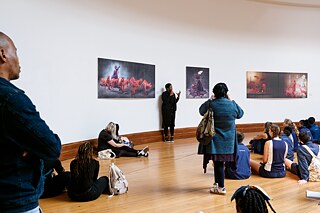
Mary Sibande standing next to her alter ego, Sophie, in her purple phase, directing a pack of vicious-looking red dogs.
-
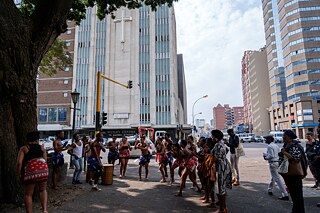
A performance from KCAP on the corner of Smith and Aliwal streets. The background features the church with brutalist architecture.
-
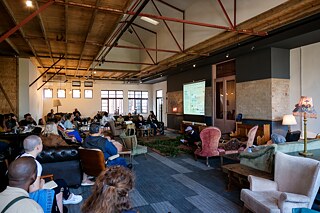
Animateur Russel Hlongwane, nestled in the wreath.
-
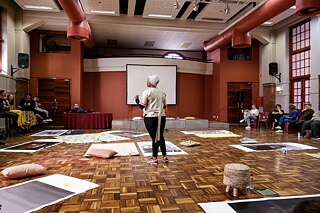
The reflecteur, Nocebo Bucibo, facilitating a session at the Diakonia Centre.
